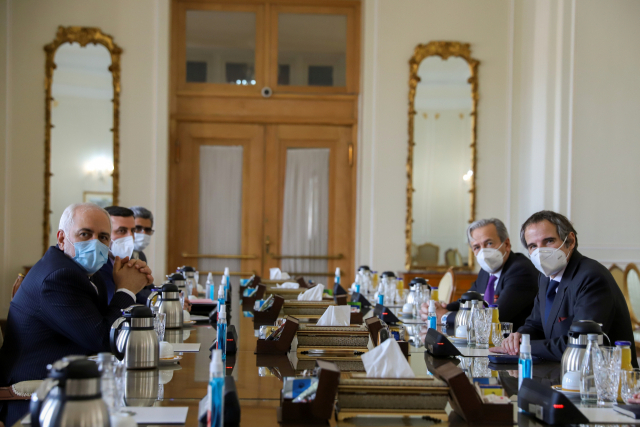Concerned about the existence of nuclear material in the unreported area of Iran
Turkuzabad region of Tehran
Concern expressed through IAEA report
Iran formalizes restrictions on IAEA inspections
Young, French and German condemned Iran
Reporter Yoon Yeo-jin [email protected]
Input: 2021-02-24 06:59:54Revision: 2021-02-24 07:01:34Published: 2021-02-24 07:02:19



On the 21st (local time) in Tehran, Iran, Iranian Foreign Minister Mohammad Jamad Zarif (left) and Iranian Foreign Minister Rafael Grossey (right) met with the Secretary-General of the International Atomic Energy Agency (IAEA) to discuss issues related to nuclear inspection. Reuters Yonhap News
The International Atomic Energy Agency (IAEA) expressed deep concern over the possible presence of nuclear material in Iran’s unreported area.
According to the AFP news agency on the 23rd (local time), the IAEA stated in a report that “unreported nuclear material may have existed in the unreported area, and under the Safeguard Agreement (Nuclear Safety Measures Agreement), such nuclear material remained unreported. I am deeply concerned that there is.” “After 18 months, Iran has not provided an essential, complete and technically reliable explanation of the existence of nuclear material particles,” he noted.
The area in question is Turkuzabad, Tehran, where Israel previously designated Iran’s secret nuclear activity site. AFP said there was no evidence of processing uranium at the site, but there is a possibility that it was used for uranium storage at the end of 2018.
In addition, the IAEA announced in a separate report that Iran’s stockpile of enriched uranium exceeded 14 times the nuclear agreement (Comprehensive Joint Action Plan) allowed. Iran’s stockpile is 2967.8 kg as of the 16th, which is more than 14 times more than the storage capacity allowed by the nuclear agreement (202.8 kg based on uranium isotopes).
Meanwhile, Iran officially announced that it would restrict inspections by the IAEA from the 23rd if the parties to the nuclear agreement do not fulfill their obligations by the 21st.
The Iranian nuclear agreement was signed by Britain, France, Germany, the United States, Russia, and China in 2015 with Iran. Iran gave up nuclear development and six countries lifted economic sanctions against Iran. However, when former U.S. President Donald Trump unilaterally declared the breach of the nuclear agreement in 2018, Iran gradually reduced the scope of implementation of the terms of the nuclear agreement from May 2019. Until now, the IAEA has inspected Iran’s nuclear facilities without restrictions on the basis of the Additional Protocol to the Nuclear Agreement.
Three European countries (E3), including Britain, France and Germany, who signed the Iranian nuclear agreement, immediately condemned Iran. Ministers of foreign affairs of the three countries made a joint statement on the day and expressed deep regret, saying, “Iran’s action is a violation of the nuclear agreement and greatly undermines the supervisory authority of the IAEA.”
Reporter Yoon Yeo-jin [email protected]·Some Yonhap News
